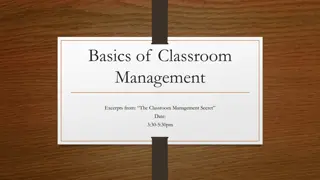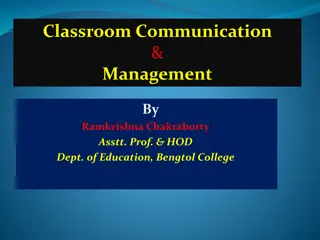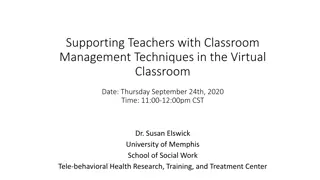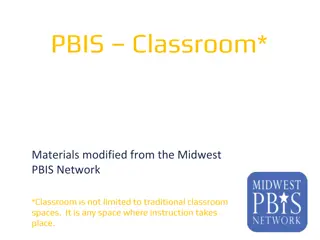Burnaby 2016: Innovative Classroom Strategies
Burnaby 2016 presents a comprehensive exploration of building thinking classrooms through various strategies such as Mimicking, Slacking, Checking Understanding, and more. The findings highlight the positive impact of engaging tasks, managing flow, oral versus written questioning, room organization, and more. Discover effective practices for enhancing student engagement and learning outcomes
Download Presentation

Please find below an Image/Link to download the presentation.
The content on the website is provided AS IS for your information and personal use only. It may not be sold, licensed, or shared on other websites without obtaining consent from the author.If you encounter any issues during the download, it is possible that the publisher has removed the file from their server.
You are allowed to download the files provided on this website for personal or commercial use, subject to the condition that they are used lawfully. All files are the property of their respective owners.
The content on the website is provided AS IS for your information and personal use only. It may not be sold, licensed, or shared on other websites without obtaining consent from the author.
E N D
Presentation Transcript
What is Plasma ? What is Plasma ? What are the basic phenomena in What are the basic phenomena in a plasma? a plasma? Basanta Pathak Associate Professor Dept. of Physics Haflong Govt. College
Plasma is a set of quasi-neutral particles with free electric charge carriers, which behave collectively. The most important part is that free electric charge carriers are found in the plasma state of matter. Atoms are at least partially ionized. The degree of ionization does not have to be too large, if the size of the plasma formation is big enough. A plasma is conductive and reacts strongly to electric and magnetic fields. The second quality is its quasi-neutrality. Let us assume a certain volume, which microscopically shows in average the same quantity of positive and negative particles. The plasma behaves as if it were a fluid without charge ( i.e. in liquid or gas) The demanding of quasi-neutrality excludes the beams of charged particles from the definition of plasma.
The last part of the definition of plasma is collective behaviour. With this it is understood that plasma as a whole is capable of processes that general electric and magnetic fields to which plasma can react in turn. The plasma definition does not include the beams of charged particles since they do not fulfill the requirement of quasi-neutrality. Neither are included the very weekly ionized gases, like the flame of a candle ( they do not fulfill the requirement of collective behaviour.) The plasma concept was used for the first time by Irwing Langmuir (1881- 1957). The plasma state of matter can be subdivided into few more groups: .. 1. Common Plasma 2. Thermonuclear Plasma 3. Nucleon Plasma 4. Quark Gluon Plasma
A plasma has the tendency of creating surface or filament formations the plasma fiber or pinch and the current surfaces or pinched walls. The plasma projects phenomena which are collectively known as drifts movement of particles perpendicular to a magnetic field or other force fields. Through a plasma can be expanded an enormous quantity of different kinds of waves- the magneto acoustic waves, to which belong for example the well known Alfven waves which are the analogy of the acoustic waves in gases, and the electromagnetic waves of many different modes. These waves are also very easily generated in plasma. A plasma can reach a whole range of instabilities, which have as consequence, for example, the short time radiation of certain energy quantities leading to certain characteristics structures. To plasma belongs without doubt radiation due to the electron atom recombination, bremstrahlung radiation and Synchrotron radiation, the creation of electric double layers.
The acceleration of charged particles to high energies, the magneto-hydro dynamic dynamo which produces the magnetic field inside our sun and the planets, and many more interesting phenomena. People can create plasma in the laboratory. The examples are . 1. Laser Plasma 2. Pulsed Plasma 3. Tokmak 4. Cold Plasma























